RBSE Solutions for Class 12 Biology Chapter 3 Human Reproduction
Rajasthan Board RBSE Solutions for Class 12 Biology Chapter 3 Human Reproduction Textbook Exercise Questions and Answers.
Rajasthan Board RBSE Solutions for Class 12 Biology in Hindi Medium & English Medium are part of RBSE Solutions for Class 12. Students can also read RBSE Class 12 Biology Important Questions for exam preparation. Students can also go through RBSE Class 12 Biology Notes to understand and remember the concepts easily. Browsing through manav janan class 12 in hindi that includes all questions presented in the textbook.
RBSE Class 12 Biology Solutions Chapter 3 Human Reproduction
RBSE Class 12 Biology Human Reproduction Textbook Questions and Answers
Question 1.
Fill in the blanks:
(a) Human reproduce ................ (asexually/sexually).
Answer:
sexually

(b) Human are ................ (oviparous, viviparous, oviparous)
Answer:
viviparous
(c) Fertilization is ................ in humans, (external/ internal)
Answer:
internal
(d) Male and female gametes are ................ (diploid/ haploid)
Answer:
haploid
(e) Zygote is ................ (diploid/haploid)
Answer:
diploid
(f) The process of release of ovum from a mature follicle is called ................
Answer:
ovulation
(g) Ovulation is induced by a hormone called ................
Answer:
luteinizing hormone (LH)
(h) The fusion of male and female gametes is called ................
Answer:
fertilization
(i) Fertilization take place in ................
Answer:
ampulla of oviduct
(j) Zygote divides to form ................ which is implanted in uterus.
Answer:
blastocyst
(k) The structure which provides vascular connection between foetus and uterus is called ................
Answer:
placenta
Question 2.
Draw a labelled diagram of male reproductive system.
Answer:
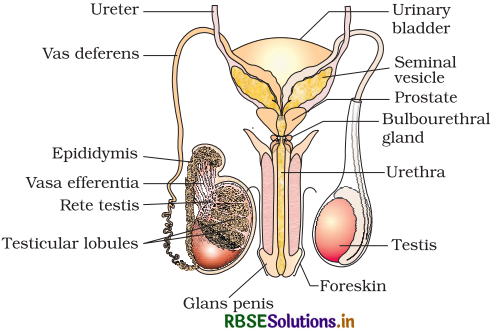
Question 3.
Draw a labelled diagram of female reproductive system.
Answer:
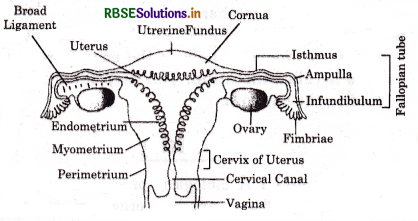
Question 4.
Write two major functions each of testis and ovary.
Answer:
Functions of Testes:
- The process of spermatogenesis produces sperms through the seminiferous tubules of testes.
- Testosterone, the male sex hormone is secreted by the leydig cells of testes.
Functions of Ovary:
- In ovaries, the process at oogenesis produces ova.
- Progesteron and oesteogen, the female hormones are secreted by ovaries.
Question 5.
Describe the structure of a seminiferous tubule.
Answer:
Structure of Seminiferous tubules:
- Seminiferous tubules are found in the testicular lobules and these are highly coiled structures. It is the site where the production of sperm in the testes occurs.
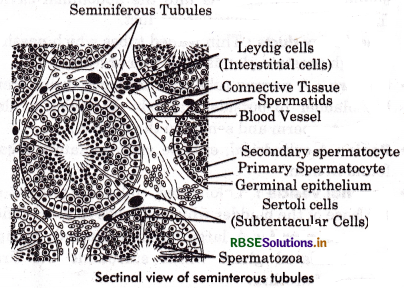
- Each of the seminiferous tubule has a lining of germinal epithelium.
- On the inner side, it is lined by two types of cells: sertolicells and spermatogonia.
- Spermatogonia: These are the male germ cells that produce the primary spermatocytes through the process of meiotic divisions. The primary spermatocyte furthermore undergoes meiotic divisions for the formation of secondary spermatocytes and ultimately spermatids. Later on, spermatids metamorphosize into the male gametes termed as spermatozoa.
- Sertoli cells: These are referred to as nurse cells of the testes. It is because they nourish the germ cells.
- Just adjacent to the seminiferous tubules, there are large polygonal cells referred to as leydig cells of interstitial cells which secrete the male hormone testosterone.
Question 6.
What is spermatogenesis? Briefly describe the process of spermatogenesis.
Answer:
Spermatogenesis:
The phenomenon of sperm production from the immature germ cells in males is termed as spermatogenesis. The process occur in the seminiferous tubules located inside the testes. In this process a diploid (2n) male germ cell or spermatogonium enlarges (in size) for the formation of a diploid primary spermatocyte which inturn goes through the first meiotic division or meiosis I. This division is a reductional division for the formation of two equal haploid secondary spermatocytes, each of which further undergoes second meiotic division or meiosis II for the formation of two equal haploid (n) spermatids. Subsequently, four haploid spermatids are formed from a diploid spermatogonium. The spermatids hence produced form spermatozoa (sperm) through the process of spermiogenesis.
Question 7.
Name the hormones involved in regulation of spermatogenesis.
Answer:
Some hormones involved in the regulation of spermatogenesis are as following:
- Lutenising Hormone (LH): Serves as Leydig cells triggering synthesis and secretion of androgens.
- Gonadotropin Releasing Hormone (GnRH): It is a hypothalamic hormone which is secreted at the age of puberty, acting at the anterior pituitary gland and stimulating the section of LH and FSH.
- Follicle Stimulating Hormone (FSH): Acts on sertolicells, stimulating the secretion of factors which aid in spermotogenesis process.
- Androgen: Triggers inhibin production regulating the spermatogenesis process.
- Inhibin: Regulates spermatogenesis process.
Question 8.
Define spermiogenesis and spermiation.
Answer:
Spermiogenesis: It is the process of transformation of non - motile spermatids to mature, motile spermatozoa.
Spermiation: It is the process where mature spermatozoa are released from the sertoli cells into the lumen of the seminiferous tubules of the testes.

Question 9.
Draw a labelled diagram of sperm.
Answer:
The diagram of sperm is as below:
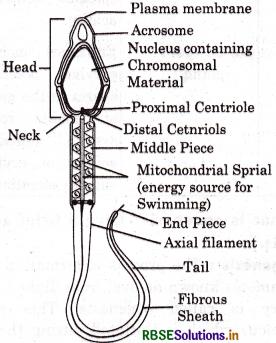
Question 10.
What are the major components of seminal plasma?
Answer:
The major components of seminal plasma are:
- Secretion of the accessory reproductive glands of male - prostate gland, seminal vesicle, bulboure - thral glands.
- Mainly composed of calcium, fructose and other enzymes.
Question 11.
What are the major functions of male accessory ducts and glands?
Answer:
The major functions at the male accessory ducts and glands are:
|
Ducts/ Glands |
Name of Particulates |
Functions |
|
Male accessory ducts |
(i) Vas efferentia |
Conducts sperm from the rete |
|
|
(ii) Rete testis |
Stores sperms that is produced by seminiferous tubules. |
|
|
(iii) Vas Deferntia |
Conducts sperms from epididymis to the urethra. |
|
|
(iv) Epididymis |
Physiological maturation of sperms storage and nourishment. |
|
Male accessory gland |
(i) Seminal Vesicle |
Activates and provides energy to the facilitate sperm motility after ejaculation. |
|
|
(ii) Prostate gland |
Nourishment and activates sperms, enhances sperm motility, provides alkalinity to the ejaculate, neutrilizes urine acidity. |
|
|
(iii) Cowper’s gland |
Enhances mobility and survival potentiality of sperm in the genital tract of female reproductive system, neutrilizes the acidity of acidic female vaginal secretions. |
Question 12.
What is oogenesis? Give a brief account of oogenesis.
Answer:
Oogenesis: The process of formation of haploid female gametes known as ova, from diploid oogonia in the ovary is called oogenesis. This process is discontinuous which is initiated during the period of foetal development that is terminated only after puberty sets in. The process of oogenesis takes place in three phases:
1. Multiplication Phase: Follicle cells are differentiated from the germinal epithelium of the ovary due to repeated mitotic divisions. Few follicle cells enlarge and are termed as egg mother cells and undergo mitosis to multiply which are refered to as oogonia.
2. Growth Phase: One of the oogonium of the egg nest differentiates while the rest change into surrounding nutritive follicular epithelium. There is an increase in the size of the differentiated isolated ooganium as it gets nourished from the girdling follicle cells thereby transforming into a diploid primary oocyte.
3. Maturation Phase: The diploid primary oocyte in this phase passes through two maturation divisions. Meiosis - I: The first meiotic division splits the diploid primary oocyte into two haploid (n) cells wherein the larger one is the secondary oocyte and the tiny one is the polar body. In Meiosis - II, the secondary oocyte splits to form one large ootid and a tiny second polar body. Furthermore, the first polar body divides through mitosis to form two polar bodies. The ootid matures into a functional haploid ovum. Therefore single primary oocyte produces one large ovum and three polar bodies which inturn degenerate.
Question 13.
Draw a labelled diagram of a section through ovary.
Answer:
The diagram of a section of an ovary is as follows:
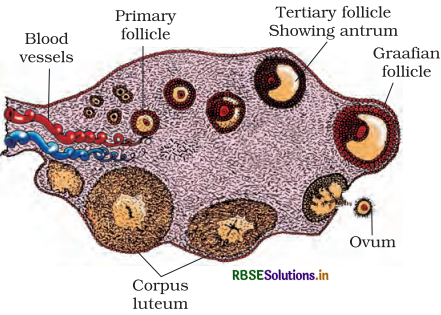
Question 14.
Draw a labelled diagram of a Graafian follicle.
Answer:
The diagram of a Graafian follicle:
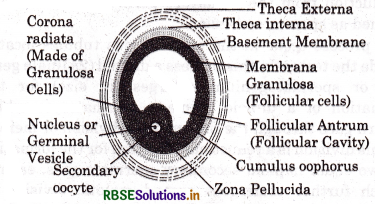
Question 15.
Name the functions of the following:
(a) Corpus luteum
(b) Endometrium
(c) Acrosome
(d) Sperm tail
(e) Fimbriae.
Answer:
(a) Corpus Luteum: It acts as an endocrine gland and secrete progesterone hormone which essential for maintenance of the endometrium.
(b) Endometrium: It is, the innermost layer of uterus responsible for nutrition and development of the foetus. It undergoes cyclic changes during menstrual cycle. Implantation of blostocyst takes place on the endometrium.
(c) Acrosome: It has hydrolytic enzymes that help in dissolving membranes of the ovum for fertilization.
(d) Sperm tail: It helps in the sperm movement in the female genital tract for fertilization.
(e) Fimbriae: It is present at the opening at oviduct which helps in the collection of eggs after ovulation.
Question 16.
Identify True / False statements. Correct each false statement to make it true.
(a) Androgens are produced by sertoli cells.
Answer:
False: Androgens are produced by Leydig cells that are present in the seminiferious tubules.
(b) Spermatozoa get nutrition from sertoli cells.
Answer:
True
(c) Leydig cells are found in ovary.
Answer:
False: Leydig cells are present in the seminiferous tubules of the testis in males.
(d) Leydig cells synthesise androgens.
Answer:
True
(e) Oogenesis takes place in corpus luteum.
Answer:
False: Oogenesis occurs in the ovary.
(f) Menstrual cycle ceases during pregnancy.
Answer:
True
(g) Presence or absence of hymen is not a reliable indicator of virginity or sexual experience.
Answer:
True

Question 17.
What is menstrual cycle? Which hormones regulate menstrual cycle?
Answer:
Menstrual Cycle: It is a series of cyclic physiological changes occuring in the female reproductive tract in primates, the end of which is combined with the collapsing of the uterine endometrium that is liberated in the form of blood and mucus through the vaginal opening, which is termed as menses. This cycle lasting for around 28 days on an average to complete.
Hormones: The different hormones that regulate the menstrual cycle are: Leutinizing Hormone (LH), Follicles Stimulating Hormone (FSH), Progesteron and estrogen. During the follicular phase, the level of LH and FSH that is secreted from the anterior pituitary gland, increases. The FSH that is secreted under the effect of the releasing hormone (RH) from the hypothalamus, triggers the primary follicle to convert into a Graafian follicle. There is a gradual increase in the level of LH which causes the follicle to grow, also causing the secretion of estrogen.
Estrogen obstructs the FSH secretion, triggering the secretion of the LH, which also results in the thickening of the uterine endometrium. The amlified secretion of LH also results in the Graafian follicle to rupture, thereby causing the release of the ovum into the fallopian tube. This ruptured Graafian follicle transforms into corpus luteum which secretes the hormones progesteron during the luteal phase. The hormone progesterone assists in maintaining and preparing the endometrium for the process of embryo - implantation. When the progesterone level in the blood is high, the FSH and LH secretion decreases which furthermore hinders the process of ovulation.
Question 18.
What is parturition? Which hormones are involved in induction of parturition?
Answer:
Parturition: It is the process wherein a fully developed foetus from mother’s uterus, is expelled out after the completion of the gestation period.
Following hormones are involved in induction of parturition:
- Oxytocin: It directs the full - term foetus towards the birth canal, as it causes the contraction of the smooth muscles of the myometrium of the uterus leading the baby to be expelled out.
- Reloxin: It relaxes the pelvic ligaments, widening the public symphysis to assist in an easier childbirth.
Question 19.
In our society the women are often blamed for giving birth to daughters. Can you e plain why this is not correct?
Answer:
As we know that human beings have 23 pairs of chromosomes. Out of these, we have 22 pairs of autosomes and the last pair varies in males and females. Males are heterogametic i.e., they produce two types of male gametes or sperms, where 50% of the sperms carry the ‘X’ chromosomes (22 + X), while the rest 50% carry the Y chromosomes (22 + Y). On the other hand females are homogametic i.e., they produce only one type of gametes the ova, each of which carries the ‘X’ chromosomes (22 + X) only.
Once the male and female gametes have fused to form the zygote, it would carry either XX chromosomes (44 + XX) or ‘XT chromosomes (44 + XY), depending on whether sperm carrying ‘X’ or Y fertilized the ovum. Hence, if the sperm carrying ‘X’ fertilizes the ovum (zygote; 44 + XX), then it would develop into a female baby and if the sperm carrying Y fertilizes the ovum (Zygote; 44 + XY), then it would develop into a male baby. Both of these cases are attributed to the sperm that carries the chromosome fertilizing the ovum. Hence, we say that the sex of the child is determined by the male and do not the female. This is why it is incorrect to blame women for the gender of the child.
Question 20.
How many eggs are released by a human ovary in a month? How many eggs do you think would have been released if the mother gave birth to identical twins? Would your answer change if the twins born were fraternal?
Answer:
Typically in a month, human ovaries releases only one egg, rarely two. In case of identical twins or monozygotic twins, one egg is released by the ovary which splits into two after fertilization. This is why identical twins exhibit the same genetic features. On the other hand in fraternal twins or dizygotic twins, two eggs are released which are fertilized by two different sperms causing the fraternal twins to exhibit different genetic characters.
Question 21.
How many eggs do you think were released by the ovary of a female dog which gave birth to 6 puppies?
Answer:
In order to have given birth to six puppies, the ovary at the female dog released six eggs. Hence, six zygote were formed for each to develop into a puppy.

- RBSE Class 12 Biology Notes Chapter 16 पर्यावरण के मुद्दे
- RBSE Class 12 Biology Notes Chapter 15 जैव-विविधता एवं संरक्षण
- RBSE Class 12 Biology Notes Chapter 14 पारितंत्र
- RBSE Class 12 Biology Notes Chapter 13 जीव और समष्टियाँ
- RBSE Class 12 Biology Notes Chapter 12 जैव प्रौद्योगिकी एवं उसके उपयोग
- RBSE Class 12 Biology Notes Chapter 11 जैव प्रौद्योगिकी-सिद्धांत व प्रक्रम
- RBSE Class 12 Biology Notes Chapter 10 मानव कल्याण में सूक्ष्मजीव
- RBSE Class 12 Biology Notes Chapter 9 खाद्य उत्पादन में वृद्धि की कार्यनीति
- RBSE Class 12 Biology Notes Chapter 8 मानव स्वास्थ्य तथा रोग
- RBSE Class 12 Biology Notes Chapter 7 विकास
- RBSE Class 12 Biology Notes Chapter 6 वंशागति के आणविक आधार